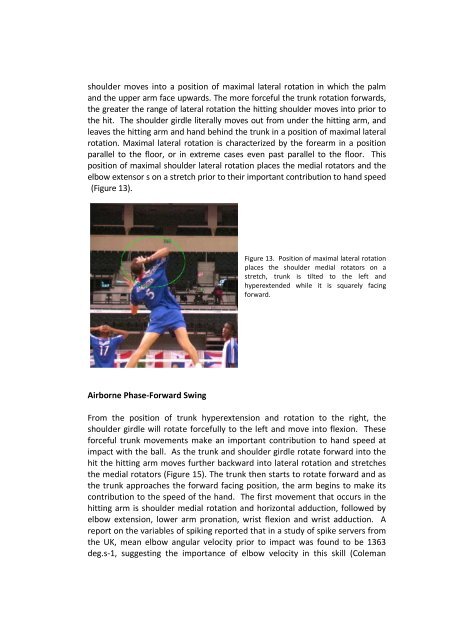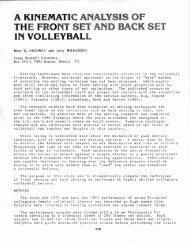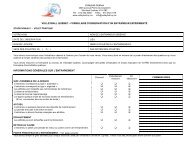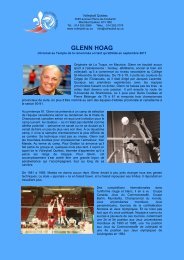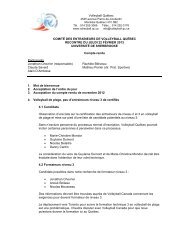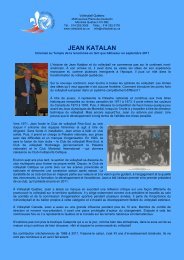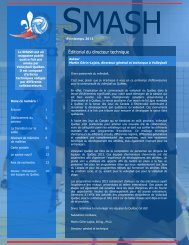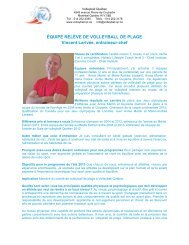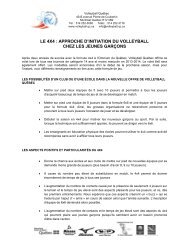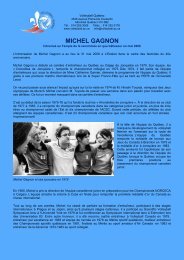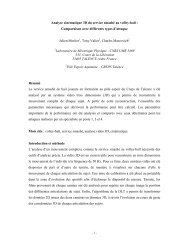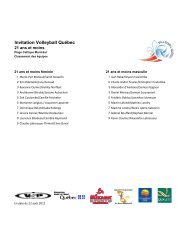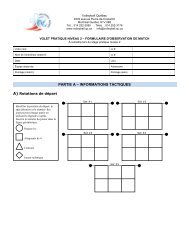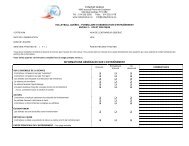An Analysis of the volleyball serve
An Analysis of the volleyball serve
An Analysis of the volleyball serve
Create successful ePaper yourself
Turn your PDF publications into a flip-book with our unique Google optimized e-Paper software.
shoulder moves into a position <strong>of</strong> maximal lateral rotation in which <strong>the</strong> palm<br />
and <strong>the</strong> upper arm face upwards. The more forceful <strong>the</strong> trunk rotation forwards,<br />
<strong>the</strong> greater <strong>the</strong> range <strong>of</strong> lateral rotation <strong>the</strong> hitting shoulder moves into prior to<br />
<strong>the</strong> hit. The shoulder girdle literally moves out from under <strong>the</strong> hitting arm, and<br />
leaves <strong>the</strong> hitting arm and hand behind <strong>the</strong> trunk in a position <strong>of</strong> maximal lateral<br />
rotation. Maximal lateral rotation is characterized by <strong>the</strong> forearm in a position<br />
parallel to <strong>the</strong> floor, or in extreme cases even past parallel to <strong>the</strong> floor. This<br />
position <strong>of</strong> maximal shoulder lateral rotation places <strong>the</strong> medial rotators and <strong>the</strong><br />
elbow extensor s on a stretch prior to <strong>the</strong>ir important contribution to hand speed<br />
(Figure 13).<br />
Figure 13. Position <strong>of</strong> maximal lateral rotation<br />
places <strong>the</strong> shoulder medial rotators on a<br />
stretch, trunk is tilted to <strong>the</strong> left and<br />
hyperextended while it is squarely facing<br />
forward.<br />
Airborne Phase-Forward Swing<br />
From <strong>the</strong> position <strong>of</strong> trunk hyperextension and rotation to <strong>the</strong> right, <strong>the</strong><br />
shoulder girdle will rotate forcefully to <strong>the</strong> left and move into flexion. These<br />
forceful trunk movements make an important contribution to hand speed at<br />
impact with <strong>the</strong> ball. As <strong>the</strong> trunk and shoulder girdle rotate forward into <strong>the</strong><br />
hit <strong>the</strong> hitting arm moves fur<strong>the</strong>r backward into lateral rotation and stretches<br />
<strong>the</strong> medial rotators (Figure 15). The trunk <strong>the</strong>n starts to rotate forward and as<br />
<strong>the</strong> trunk approaches <strong>the</strong> forward facing position, <strong>the</strong> arm begins to make its<br />
contribution to <strong>the</strong> speed <strong>of</strong> <strong>the</strong> hand. The first movement that occurs in <strong>the</strong><br />
hitting arm is shoulder medial rotation and horizontal adduction, followed by<br />
elbow extension, lower arm pronation, wrist flexion and wrist adduction. A<br />
report on <strong>the</strong> variables <strong>of</strong> spiking reported that in a study <strong>of</strong> spike <strong>serve</strong>rs from<br />
<strong>the</strong> UK, mean elbow angular velocity prior to impact was found to be 1363<br />
deg.s-1, suggesting <strong>the</strong> importance <strong>of</strong> elbow velocity in this skill (Coleman


